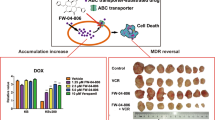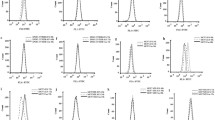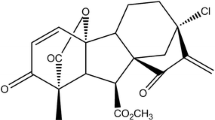Abstract
Purpose
H1 is a novel derivative of tetrandrine (Tet). Here we investigate the ability of H1 to reverse P-glycoprotein (Pgp)-mediated multidrug resistance (MDR) and its mechanisms.
Methods
KBv200, MCF-7/adr and their parental sensitive cell lines KB, MCF-7 were used for reversal study. The intracellular accumulation and efflux studies with Pgp substrates of doxorubicin and rhodamine 123 were determined by flow cytometry. The expression of Pgp was investigated by Western blot and RT-PCR analysis. ATPase activity of Pgp was performed by Pgp-Glo™ assay systems. The ubiquitination level of Pgp was determined by immunoprecipitation analysis. The effect of ERK1/2 on Pgp expression in KBv200 cells were investigated by RNA interference.
Results
H1 significantly potentiated the sensitivity of Pgp substrates in KBv200 and MCF-7/adr cells, but not in parental cells KB and MCF-7. H1 inhibited Pgp expression in KBv200 cells in a dose-dependent manner, but had no effect on MDR1 expression. Further studies showed that H1 prompted the degradation of Pgp and decreased Pgp protein half-life by enhancing the ubiquitination of Pgp, which may be related to downregulated MEK-ERK signal pathway. We also found H1 inhibited ATPase activity of Pgp in a dose-dependent manner.
Conclusions
H1 is an effectively and potential agent in reversing Pgp-mediated MDR by inhibiting the transport function and expression of Pgp.





Similar content being viewed by others
References
Nobili S, Landini I, Giglioni B, Mini E (2006) Pharmacological strategies for overcoming multidrug resistance. Curr Drug Targets 7:861–879
Szakacs G, Paterson JK, Ludwig JA, Booth-Genthe C, Gottesman MM (2006) Targeting multidrug resistance in cancer. Nat Rev Drug Discov 5:219–234
Staudinger R, Knaus HG, Glossmann H (1991) Positive heterotropic allosteric regulators of dihydropyridine binding increase the Ca2+ affinity of the L-type Ca2+ channel. Stereoselective reversal by the novel Ca2+ antagonist BM 20.1140. J Biol Chem 266:10787–10795
Fu L, Liang Y, Deng L, Ding Y, Chen L, Ye Y, Yang X, Pan Q (2004) Characterization of tetrandrine, a potent inhibitor of P-glycoprotein-mediated multidrug resistance. Cancer Chemother Pharmacol 53:349–356
Fu LW, Zhang YM, Liang YJ, Yang XP, Pan QC (2002) The multidrug resistance of tumour cells was reversed by tetrandrine in vitro and in xenografts derived from human breast adenocarcinoma MCF-7/adr cells. Eur J Cancer 38:418–426
Jin J, Wang FP, Wei H, Liu G (2005) Reversal of multidrug resistance of cancer through inhibition of P-glycoprotein by 5-bromotetrandrine. Cancer Chemother Pharmacol 55:179–188
Chen LM, Liang YJ, Zhang X, Su XD, Dai CL, Wang FP, Yan YY, Tao LY, Fu LW (2009) Reversal of Pgp-mediated multidrug resistance by Bromotetrandrine in vivo is associated with enhanced accumulation of chemotherapeutical drug in tumor tissue. Anticancer Res 29:4597–4604
Zhang XH, Zhang FY, Ji XJ, Li ZY (1994) Vincristine-resistant human KB cell line and mechanism of multidrug resistance. Yao Xue Xue Bao 29:246–251
Ullmann CA, Eliot HM, Sinha BK (1991) Distribution, DNA damage and cytotoxic effects of etoposide in human tumor xenografts in vivo. Anticancer Res 11:1379–1382
Mosmann T (1983) Rapid colorimetric assay for cellular growth and survival: application to proliferation and cytotoxicity assays. J Immunol Methods 65:55–63
Huang M, Liu G (1999) The study of innate drug resistance of human hepatocellular carcinoma Bel7402 cell line. Cancer Lett 135:97–105
Zheng LS, Wang F, Li YH, Zhang X, Chen LM, Liang YJ, Dai CL, Yan YY, Tao LY, Mi YJ, Yang AK, To KK, Fu LW (2009) Vandetanib (Zactima, ZD6474) antagonizes ABCC1- and ABCG2-mediated multidrug resistance by inhibition of their transport function. PLoS One 4:e5172
Mistry P, Stewart AJ, Dangerfield W, Okiji S, Liddle C, Bootle D, Plumb JA, Templeton D, Charlton P (2001) In vitro and in vivo reversal of P-glycoprotein-mediated multidrug resistance by a novel potent modulator, XR9576. Cancer Res 61:749–758
Zhang Z, Wu JY, Hait WN, Yang JM (2004) Regulation of the stability of P-glycoprotein by ubiquitination. Mol Pharmacol 66:395–403
Katayama K, Yoshioka S, Tsukahara S, Mitsuhashi J, Sugimoto Y (2007) Inhibition of the mitogen-activated protein kinase pathway results in the down-regulation of P-glycoprotein. Mol Cancer Ther 6:2092–2102
Dano K (1973) Active outward transport of daunomycin in resistant Ehrlich ascites tumor cells. Biochim Biophys Acta 323:466–483
Modok S, Mellor HR, Callaghan R (2006) Modulation of multidrug resistance efflux pump activity to overcome chemoresistance in cancer. Curr Opin Pharmacol 6:350–354
Mimeault M, Hauke R, Batra SK (2008) Recent advances on the molecular mechanisms involved in the drug resistance of cancer cells and novel targeting therapies. Clin Pharmacol Ther 83:673–691
Kim H, Barroso M, Samanta R, Greenberger L, Sztul E (1997) Experimentally induced changes in the endocytic traffic of P-glycoprotein alter drug resistance of cancer cells. Am J Physiol 273:C687–C702
McCubrey JA, Steelman LS, Abrams SL, Lee JT, Chang F, Bertrand FE, Navolanic PM, Terrian DM, Franklin RA, D’Assoro AB, Salisbury JL, Mazzarino MC, Stivala F, Libra M (2006) Roles of the RAF/MEK/ERK and PI3 K/PTEN/AKT pathways in malignant transformation and drug resistance. Adv Enzyme Regul 46:249–279
McCubrey JA, Steelman LS, Chappell WH, Abrams SL, Wong EW, Chang F, Lehmann B, Terrian DM, Milella M, Tafuri A, Stivala F, Libra M, Basecke J, Evangelisti C, Martelli AM, Franklin RA (2007) Roles of the Raf/MEK/ERK pathway in cell growth, malignant transformation and drug resistance. Biochim Biophys Acta 1773:1263–1284
Zhou J, Liu M, Aneja R, Chandra R, Lage H, Joshi HC (2006) Reversal of P-glycoprotein-mediated multidrug resistance in cancer cells by the c-Jun NH2-terminal kinase. Cancer Res 66:445–452
Barancik M, Bohacova V, Kvackajova J, Hudecova S, Krizanova O, Breier A (2001) SB203580, a specific inhibitor of p38-MAPK pathway, is a new reversal agent of P-glycoprotein-mediated multidrug resistance. Eur J Pharm Sci 14:29–36
Acknowledgments
This work was supported by Grants (No. 30630069) from China National Natural Sciences Foundation.
Author information
Authors and Affiliations
Corresponding author
Rights and permissions
About this article
Cite this article
Wei, N., Sun, H., Wang, F. et al. H1, a novel derivative of tetrandrine reverse P-glycoprotein-mediated multidrug resistance by inhibiting transport function and expression of P-glycoprotein. Cancer Chemother Pharmacol 67, 1017–1025 (2011). https://doi.org/10.1007/s00280-010-1397-7
Received:
Accepted:
Published:
Issue Date:
DOI: https://doi.org/10.1007/s00280-010-1397-7




